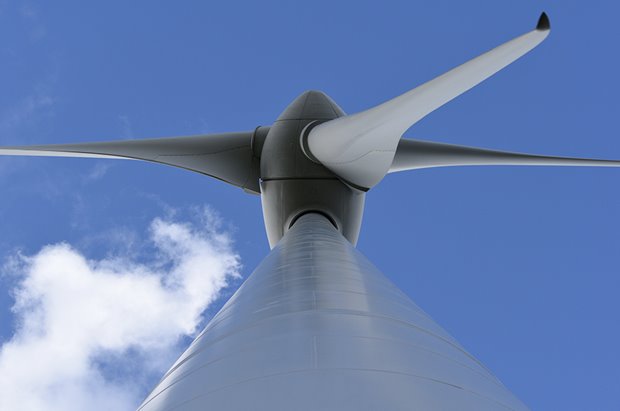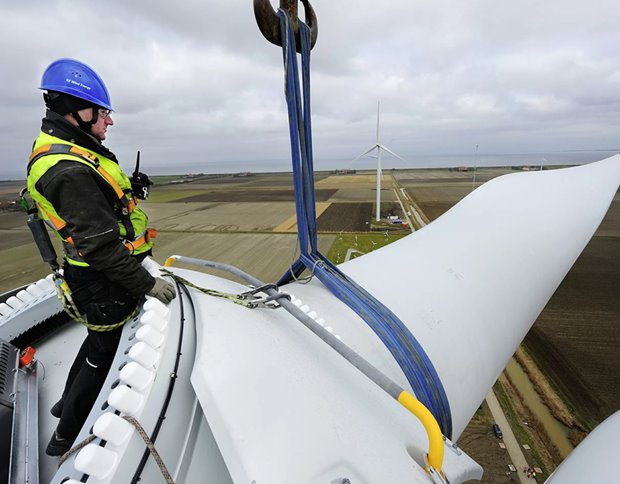How Have Windmills Changed As Technology Has Advanced?
While wind turbines may no longer exist a novel sight for many Americans, the use of wind energy continues to grow. So exercise the the turbines that convert the air current's kinetic energy into electric energy.
Even among a global pandemic, 2020 was a banner twelvemonth for the Us air current industry, which saw wind-farm developers commissioning 16,913 MW of wind chapters, an 85 percent increase over 2019, according to the American Clean Power Association (ACP).
With 2021 shaping up to be some other big important year for air current energy, hither are half dozen changes to wind turbine structure, siting, and manufacturing industry experts say we'll come across in the nigh- and short-term time to come.
1. Bigger Blades
Ten years ago the length of the rotor blade, from vertex to tip, measured 30 meters to twoscore meters long, about 115 feet. Today'southward blades are double that length, said John Hensley, vice president of inquiry at ACP.
At 140 meters (460 anxiety) from tip-to-tip, blade bridge at present equals the wingspan on the average passenger airplane, Hensley said. The greater the radius of the rotor blades, the more than current of air can access and, in turn, the greater the torque to power the electrical generators.
And bract size, along with turbine top, will simply continue to grow in coming years.
2. Taller Towers
Wind turbines and their towers are only getting larger and taller. GE Renewable Energy's Haliade X offshore wind turbine will generate 12 MW, 13 MW, or 14 MW, depending on the model. Unveiled in 2020, a paradigm is being congenital in the harbor of Rotterdam, The Netherlands. It is most one-third more powerful than the largest current of air turbine already in service.
The turning diameter of its rotor is 220 meters, longer than two American football fields. At 248 meters tall, the new towers will far exceed the attain of today'due south tallest wind turbines. Those are currently limited to heights of about 100 meters because of construction constraints on the foundation.
Related Infographic: No-Hands Inspection and Repair is Coming to Offshore Air current Farms
X years agone, most air current turbines averaged about 80 meters tall in height, but not all installations are better served past sending their turbines college, Hensley said. "How quickly wind-speeds alter with height varies by location," he said.
For instance, if the current of air blows at a steady lxxx mph across a site, taller towers aren't needed. "Y'all can build at 80 meters and still be in a good wind," he added. "Only in Indiana, y'all'd have to build higher to be in a identify to reach those wind speeds, he noted.
three. Increased Free energy Product
Bigger blades size and taller turbines brand for stronger product chapters. For comparison, the average turbine of 1 decade back had the capacity to produce one.5 megawatts of power. Since so they have grown in capacity, with GE's Haliade X at present the largest. Just many are smaller. The average nameplate of newly installed state-based air current turbines in the U.S. in 2019 was two.55 MW, according to Wind Exchange, a U.S. Department of Energy platform for science and wind-energy data. Those numbers will proceed to rise across Haliade 10.
4. Onsite Assembly
Larger blades may be twirling up loftier, but those huge blades cause transportation woes on the footing, Hensley said. Their size and shape requires specialized trucking routes, permit applications, and the proper vehicles, equipment, and technicians. Even if they move along highways and interstates in the expressionless of night, the huge equipment can however cause traffic bottlenecks.
Recommended for Yous: Wind Farms Operate in the Deject
The idea is to make the blades easier to ship past creating them of segmented pieces, which can later be fit together. Still at the prototype stage, this idea is getting a warm response from industry. The blades would arrive in two pieces—each lxx to 80 meters long—and could be fit together onsite, Hensley said.
Some groups are experimenting with new composites like carbon fiber or other light material that could make onsite assembly easier. The Section of Energy recently awarded GE Renewable Energy, Oakridge National Laboratory and the National Renewable Free energy Lab $half dozen.7 million to develop an additive manufacturing process for new loftier-operation blade designs for futurity big rotors. The object is to brand them with recyclable materials for onshore and offshore deployment.
5. Onsite Construction
In the Usa, turbine towers are made primarily from tubular steel congenital on a concrete base. But some manufacturers are experimenting with building towers exclusively from concrete for immovability.
The concrete pieces that would make up the belfry would be fabricated onsite "so nosotros're not moving huge, chunks of concrete through difficult-to-navigate parts of the country, Hensley said. Currently, the width of the base cannot exceed 4.5 meters considering of transportation limitations. That limits the height of the turbine.
Raising turbines college calls for a mobile casting or manufacturing facility to be available on location. In some other Section of Energy-funded effort, GE Renewable Free energy, cement manufacturer LaFargeHolcim, and COBOD International are developing optimized 3D-printed concrete bases.
Take Our Quiz: The Development of Current of air Power
COBOD manufactured a 10-meter-alpine 3D-printed concrete base in 2019 using its large-calibration construction 3D-printing engineering science. The goal is to double today's 100-meter-tall transportation-based limitation. Press a pedestal onsite would avoid that outcome, and the taller structure would increase free energy product.
6. Turbine Recycling Growing
In 2017, the researchers at the Academy of Cambridge Establish for Manufacturing found waste produced by air current turbine blades could hitting an estimated 43.4 1000000 metric tons past the yr 2050. With those types of projected numbers, more wind-turbine makers are looking at ways to recycle their products when they're no longer feasible.
Wind turbine blades are made from composites, which are difficult to recycle and that stop up as landfill when their service life ends, co-ordinate to GE Renewable Energy. In December 2020, GE Renewable and Veolia of Due north American and Veolia North America signed an understanding to recycle blades removed from U.South. onshore wind, said Bob Cappadona, primary operating officer of VNA's Environmental Solutions and Services sectionalisation.
The blades will be shredded at a VNA site in Missouri and and so "used every bit a replacement for coal, sand and dirt at cement manufacturing facilities across the United States," Cappadona said. "By using air current turbine blades—that are primarily made of fiberglass—to replace raw materials for cement manufacturing, we're reducing the amount of coal, sand and minerals that are needed to produce cement."
While many of these changes are ongoing or are set for the time to come, they point to the significance current of air now plays for the global energy landscape.
Jean Thilmany is an engineering science and engineering author in Saint Paul, Minn.
Register Now for ASME Wind Digital Solutions Meridian
Source: https://www.asme.org/topics-resources/content/6-advances-in-wind-energy
Posted by: garrettwilicaut.blogspot.com




0 Response to "How Have Windmills Changed As Technology Has Advanced?"
Post a Comment